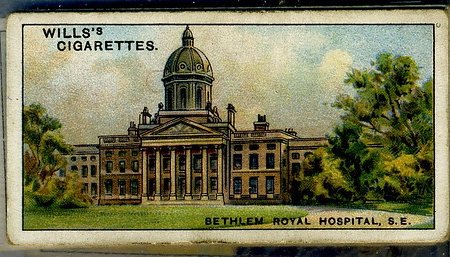Bedlam Asylum did not begin life as a place for treating the mentally ill. It was originally established (in 1247) as a collection centre for raising funds in support of the Crusades.
Three years earlier, the Kwarazmian Turks had taken Bethlehem off of Christian hands, leaving its Bishop in need of cash. A London alderman gifted him land, and Bethlem Hospital was created. This was a 'hospital' in the medieval sense of the word, meaning 'an institution supported by charity or taxes for the care of the needy'.
The following 150 years brought turmoil to Bethlem. Its Bishop relocated to France and, in the 1370s, the building was seized by Edward III. From then it was under monastic control.
Bethlem Hospital Becomes Bedlam Asylum
The first record of the mentally ill being treated at Bethlem dates back to 1403. This notes that six of its male residents were 'mente capti', a Latin term for insane. It also mentions manacles, chains and stockades.
Over the next 57 years the place was transformed from a general hospital into an institute that specialised in mental illness.
At the same time, locals began to refer to it as 'Bedlam'. Back then, this was nothing more than a slang term for Bethlehem, but, thanks to the asylum's growing notoriety, people soon grew to associate the word with madness.
The Reputation Of Bedlam Asylum Grows
Why was Bedlam so infamous? Its management did not hide its patients from the public eye, but instead exhibited them as a means of getting funds.
Evidence of this dates back to as early as 1522. Thomas More (of Utopia fame) commented that 'thou shalt in Bedleem see one laugh at the knocking of a head against post'. Although More might have been there for official purposes, it was not long before Bedlam Asylum opened its doors to the wider public.
The Bedlam Asylum Show
In 1610, a Lord Percy paid ten shillings for the privilege of wandering its grounds to take a look at its patients, and it is speculated that he might not have been the first to do this.
Some suggest that Bedlam had been giving public displays of its residents since 1598, and this seems likely, it having been used as a setting in plays from 1604 onwards.
The fact was that Bedlam Asylum was in need of funds and its management had decided the best way to get them was to show its patients off to wealthy members of the public. The worse their condition the better: they were more likely to solicit pity.
Moral Instruction At Bedlam Asylum
Beyond the procurement of funds, the visits were also justified with appeals to moral instruction. Witnessing people in such awful conditions would serve as a deterrent, the establishment claimed, a demonstration of what would happen if you gave way to your base desires.
In effect, Bedlam became a freakshow; part of the London tourist trail.
Public visits drew an average profit of between £300-350 a year (roughly £70-80k in today's money), between 1720-70. In 1770 they were finally banned, but this had the knock-on effect of hiding staff abuses behind closed doors.
The patients were transformed from public spectacles into targets of personal sadistic abuse.
Treatment At Bedlam Asylum
As suggested by the manacles and chains mentioned above, the treatment of Bedlam's patients had likely never been anything but inhumane.
A 16th Century census states that it was not 'fitt for anye man to dwell in'. Patients were made to use piss-pots and sleep on beds of straw. Many, at the time, thought the mentally ill to be less than human. As a result, they were undisturbed to see Bedlam's residents being treated like animals.
Patients were fed on a 'lowering diet', a food regime designed to purge the body of evil spirits. In practice this meant insufficient portions of grain, meat and dairy, washed down with large amounts of beer. Not a fruit nor a vegetable in sight.
Cold bathing was another treatment that they were forced to suffer, along with bleedings, blisterings and drugs to make them excrete and vomit.
Given that all of this was seen as best practice, it is hard to imagine the torments that the patients were made to suffer at the hands of visitors. And, according to Paul Chamber's Bedlam: London's Hospital For The Mad many of the worst abuses occurred after the 1770 ban on visits.
Bedlam Asylum Becomes The Bethlem Royal Hospital Of Today
Since the construction of the original Bethlem (next to modern Liverpool Street Station), the hospital has been moved three times.
First, between 1675-76, it was rebuilt in Moorfields. To warn of what was inside this iteration had 'Melancholy' and 'Raving Madness' engraved on the stone pillars on either side of its entance.
Bedlam Asylum was again rebuilt in the early 19th Century, in St George's Fields, this time with the capacity for 364 patients and a wing for the criminally insane- a legal category added in 1816 after a delusional James Hadfield was sentenced for attempted regicide.
Today's Bethlem Royal Hospital was built in 1930 in the suburbs of Croydon. Although the modern Bethlem is a stark improvement on the Bedlam Asylums of the past, it has not lacked controversies of its own. Since 2010, at least two of its patients (Chris Brennan and Olaseni Lewis) have died whilst under restraint. There is still work to be done in regards to the treatment of England's mentally ill.
One More Thing...
In 1997, Bethlem Gallery opened to showcase the work of artists who have suffered from mental health problems. Find out more about their exhibitions here: https://bethlemgallery.com/whats-on/
Interested in finding more places like this? Try one of our Clue Hunts in London - untangle cryptic clues as a team, as you are taken on a journey to the most unique, unusual and bizarre corners of London.
Learn more about historic asylum practices around the world in our article on Sydney's Milson Island.











